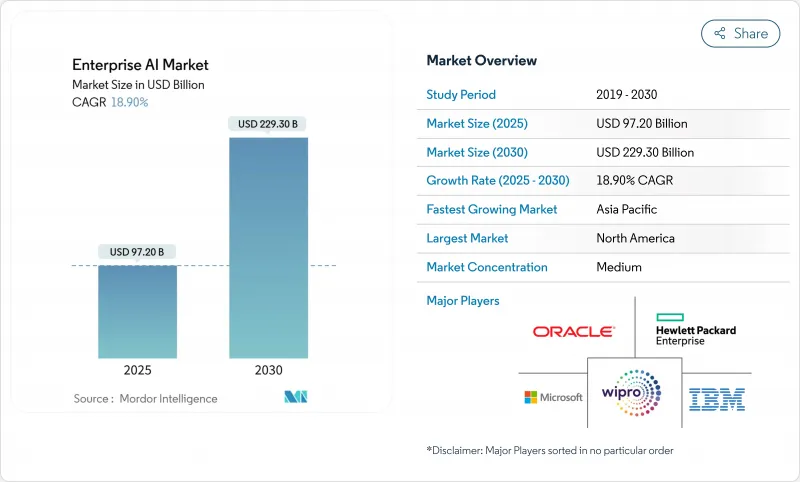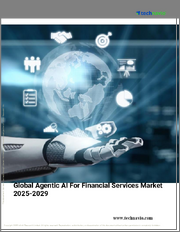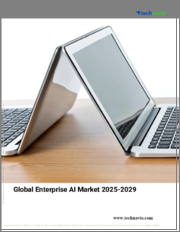
|
시장보고서
상품코드
1850400
기업용 AI 시장 : 시장 점유율 분석, 산업 동향, 통계, 성장 예측(2025-2030년)Enterprise AI - Market Share Analysis, Industry Trends & Statistics, Growth Forecasts (2025 - 2030) |
||||||
기업용 AI 시장 규모는 2025년 972억 달러로 추정되고, 2030년 CAGR 18.9%로 성장할 전망이며, 2,293억 달러에 이를 것으로 예측됩니다.

이 시장 확대의 배경에는 생성형 AI의 급속한 보급, 멀티 스텝 태스크를 자동화하는 에이전트 시스템, 추론 시간을 단축하는 전용 실리콘에 대한 수요가 증가하고 있습니다. Microsoft의 AI 포트폴리오만으로도 2025년도 연율 환산으로 130억 달러로 전년대비 175%의 성장세를 보이고 있습니다. 하드웨어 공급업체는 이러한 기세를 반영합니다. 엔비디아는 수출 규제에도 불구하고 2026년도 1분기에 441억 달러의 매출을 계상해 하이엔드 GPU 수요가 뻣뻣하다는 것을 뒷받침하고 있습니다. 클라우드가 주요 전개 경로라는 점은 변함이 없지만 하이브리드와 엣지 전개는 기업이 데이터 주권과 실시간 이용 사례를 양립시키기 위해 빠르게 진행되고 있습니다. 투자 패턴은 경쟁 환경의 성숙을 제안합니다. 벤처 캐피탈의 자금 조달액은 2024년에 1,000억 달러를 넘었지만, 거래는 더 적은 수의 후발 기업에 집중되어 향후 통합을 시사합니다.
세계의 기업용 AI 시장 동향 및 인사이트
자동화 및 AI 기반 솔루션에 대한 수요 증가
기업용 자동화는 규칙 기반 RPA를 넘어 공급망, 재무, 고객 업무에 걸친 인지 에이전트로 전환하고 있습니다. 로지스틱스에 에이전트형 AI를 통합한 조직은 동업 타사보다 61% 높은 수익 성장을 보고하고, 유니레버 등의 제조업체는 AI 주도의 최적화에 의해 설비 전체의 유효성을 85% 인상하고 있습니다. 과거에는 며칠이 걸렸던 의사 결정주기가 이제 몇 분으로 단축되어 비용 관리뿐만 아니라 보다 신속한 시장 대응을 실현하고 있습니다. 생성형 AI를 워크플로 엔진과 결합하면 인간이 스크립트를 작성하지 않고 스스로를 개선하는 적응형 프로세스 자동화가 탄생했습니다.
지수적으로 증가하는 기업 데이터 세트를 분석할 필요성
데이터 증가는 전통적인 분석 도구를 능가하고 있으며, 비즈니스 사용자가 자연어로 몇 페타바이트의 상점에 쿼리를 발행할 수 있는 대규모 언어 모델 인터페이스에 대한 수요가 증가하고 있습니다. 금융회사는 GPT 규모의 모델을 도입하고, 거래, 채팅 기록, 시장 피드를 조합하여 기내 리스크 스코어링을 실시하고, 의료 제공자는 화상과 EHR 기록을 합성해 진단을 서포트하고 있습니다. 최신 AI 스택에 탑재된 자동 데이터 발견 기능을 통해 데이터 준비 수고를 몇 달에서 며칠로 단축하여 보다 신속하게 가치를 확보할 수 있습니다.
기업 도입을 늦추는 문화 및 기술의 격차
AI 인력 부족은 사이버 보안 및 클라우드 기술에 이어 높고, 71%의 기업이 전문 지식의 갭을 최대의 병목으로 꼽고 있습니다. 특히 레거시 분야에서는 AI용으로 워크플로우를 재설계하고 있는 기업은 21%에 불과합니다. LLMOps 엔지니어와 같은 새로운 역할은 과제를 복잡하게 하고 있으며, 기업은 교육 이니셔티브를 강화하거나 관리 서비스 파트너를 추구할 필요가 있습니다.
부문 분석
2024년 기업용 AI 시장에서는 소프트웨어와 플랫폼이 48%를 차지하였고, 통합된 기능에 대한 기업 수요가 부각되었습니다. 한편, 하드웨어 가속기는 CAGR 23.11%로 가장 빠르게 성장하고 있으며, 성능에 중점을 둔 인프라 투자에 대한 축족을 보여주고 있습니다. 하드웨어의 기업용 AI 시장 규모는 조직이 프라이버시를 위해 대규모 기반 모델을 온프레미스에서 실행함에 따라 급증할 것으로 예측됩니다. 엔비디아의 데이터센터 판매는 2025년도 2분기에 263억 달러에 이르렀으며 154% 성장을 보였습니다.
커스텀 ASIC의 보급은 일반적인 CPU에서 매트릭스에 최적화된 프로세서로의 구조적 시프트를 보여줍니다. 클라우드 벤더는 이러한 가속기를 호스팅 스택에 통합하여 기업에 감가상각 부담을 가하지 않고도 신속한 스케일아웃을 실현합니다. 엣지에서 전력 효율이 뛰어난 SoC는 산업용 비전과 IoT 게이트웨이의 로컬 추론을 가능하게 하고 기업용 AI 시장을 핵심 데이터센터 외에도 확장하고 있습니다.
대기업은 여전히 절대 지출을 지배하고 있지만 중소기업은 현재 템플릿화된 모델과 SaaS 과금을 통해 고급 AI에 액세스하고 있습니다. 업종에 특화된 기반 모델은 전문 지식의 문턱을 낮추어, 카페 체인이나 부티크형 보험사가 최소한의 코딩으로 AI 채팅봇 및 수요 예측을 시작할 수 있게 합니다. 그 결과, 기업용 AI 시장은 직원 1,000명 미만의 기업으로부터의 공헌이 증가하고 있으며, 중소기업에 특화된 AI 플랫폼으로의 벤처 캐피탈의 유입과 일치하고 있습니다.
클라우드 마켓플레이스는 드래그 앤 드롭 파이프라인을 패키징하고, 관리형 서비스 회사는 데이터 준비, 미세 조정 및 모니터링을 번들로 제공합니다. AI 에이전트가 백오피스 업무를 자동화함으로써 중소기업은 지금까지 세계 기업에만 제공되었던 생산성 향상의 장점을 누리며 기업용 AI 업계의 밑단을 롱테일 부문으로까지 넓힐 수 있습니다.
기업용 AI 시장은 컴포넌트별(소프트웨어 및 플랫폼, 서비스, 하드웨어 가속기), 전개 모드별(온프레미스, 클라우드, 하이브리드 및 엣지), 조직 규모별(대기업(직원수 1,000명 이상), 중견기업(100-999명), 중소기업(100명 미만)), 기능 분야별, 기술별, 최종 사용자 산업별(BFSI, 제조업 등), 지역별도로 분류됩니다. 시장 예측은 금액(달러)으로 제공됩니다.
지역 분석
북미는 2024년 기업용 AI 시장 수익의 41.50%를 차지했으며, 750억 달러를 넘는 하이퍼스케일러의 설비 투자와 깊은 벤처 에코시스템을 지원했습니다. 미국의 정책에 따라 클라우드와 AI의 파트너십은 반경쟁적인 록인이 없는지 조사를 하게 되었으나 혁신 엔진은 여전히 견고합니다. 캐나다는 윤리를 지키면서 조사 유연성을 유지하는 균형 잡힌 거버넌스 청사진을 추구하고 멕시코는 니어 쇼어링을 활용하여 AI 투자를 제조업 회랑으로 유도하고 있습니다.
유럽은 EU AI 법을 축으로 하는 신뢰의 플랫폼을 채용해, 설명 가능성을 중시한 솔루션을 형성하고 있습니다. 독일의 강력한 산업 기반은 AI를 활용한 자동화에 대한 수요를 환기하고 영국은 혁신을 추진하는 자세 아래 자국을 AI 테스트의 샌드박스로 자리매김하고 있습니다. 프랑스와 이탈리아의 이니셔티브는 윤리적인 프레임워크 및 신흥 기업 창출의 인센티브를 결합하지만 컴플라이언스 오버헤드는 시장 출시 사이클을 늘릴 수 있습니다.
아시아태평양에서는 적극적인 도입이 가장 빠르게 진행되고 있습니다. 중국은 생성형 AI의 도입률이 83%에 달하고 있지만, 미국 기업이 생산 등급의 전개로 선도하고 있어 성숙도의 격차가 부각되고 있습니다. 일본과 한국은 하드웨어 공급을 확보하기 위해 국내 반도체 공장의 규모를 확대하고 인도에서는 190억 달러의 AI 자금 조달 파도가 신흥 기업의 기세를 가속화하고 있습니다. 한편 중동 및 아프리카에서는 정부계 펀드가 사우디아라비아와 아랍에미리트(UAE)의 AI 허브를 지원하기 때문에 중동 및 아프리카 시장의 CAGR은 21.70%로 예측됩니다. 라틴아메리카에서는 인권 중시의 규제가 책정되어 책임있는 AI 플랫폼 벤더에 화이트 스페이스가 태어납니다.
기타 혜택 :
- 엑셀 형식 시장 예측(ME) 시트
- 3개월간의 애널리스트 서포트
목차
제1장 서론
- 조사의 전제조건 및 시장 정의
- 조사 범위
제2장 조사 방법
제3장 주요 요약
제4장 시장 상황
- 시장 개요
- 시장 성장 촉진요인
- 자동화 및 AI 기반 솔루션에 대한 수요 급증
- 지수적으로 증가하는 기업 데이터 세트 분석의 필요성
- 클라우드 기반 AI-as-a-Service 플랫폼 상승
- 특수한 컴퓨팅 하드웨어(GPU, TPU, NPU) 진보
- 중소기업용 AI를 민주화하는 업계별 기반 모델
- 넷 제로의 서약이, AI를 활용한 탄소 최적화 툴 뒷받침
- 시장 성장 억제요인
- 기업 도입을 늦추는 문화 및 스킬의 갭
- 데이터 주권 및 프라이버시 규제의 장애물
- 밸류체인 및 공급망 분석
- 규제 상황
- 기술의 전망
- 모델 연산 및 프롬프트 연산의 진화
- 엣지 추론 가속
- Porter's Five Forces 분석
- 구매자의 협상력
- 공급기업의 협상력
- 신규 참가업체의 위협
- 대체품의 위협
- 경쟁 기업간 경쟁 관계
- 거시 경제 동향이 시장에 미치는 영향 평가
제5장 시장 규모 및 성장 예측
- 컴포넌트별
- 소프트웨어 및 플랫폼
- 서비스
- 하드웨어 가속기
- 기업 규모별
- 대기업(직원수 1,000명 이상)
- 미드마켓(100-999명)
- 소규모 기업(100명 미만)
- 기능 분야별
- 고객 대응(CX, 마케팅, 판매)
- 운영 및 공급망
- 재무 및 위험
- 인사 및 인재
- 기술별
- 머신러닝 및 기초 모델
- 자연언어처리
- 컴퓨터 비전
- 의사결정 인텔리전스 및 최적화
- 최종 사용자 업계별
- BFSI
- 제조업
- 자동차 및 이동성
- IT 및 텔레콤
- 미디어 및 광고
- 헬스케어 및 생명과학
- 소매 및 전자상거래
- 에너지 및 유틸리티
- 기타
- 전개 모델별
- 온프레미스
- 클라우드
- 하이브리드 및 엣지
- 지역별
- 북미
- 미국
- 캐나다
- 멕시코
- 남미
- 브라질
- 아르헨티나
- 기타 남미
- 유럽
- 영국
- 독일
- 프랑스
- 이탈리아
- 기타 유럽
- 아시아태평양
- 중국
- 일본
- 인도
- 한국
- 기타 아시아태평양
- 중동 및 아프리카
- 북미
제6장 경쟁 구도
- 시장 집중도와 점유율
- 전략적 개발
- 기업 프로파일
- Microsoft Corporation
- IBM Corporation
- Amazon Web Services Inc.
- Google LLC
- Oracle Corporation
- Hewlett Packard Enterprise
- NVIDIA Corporation
- SAP SE
- Intel Corporation
- Wipro Limited
- NEC Corporation
- Accenture plc
- ServiceNow Inc.
- DataRobot Inc.
- UiPath Inc.
- C3.ai Inc.
- Palantir Technologies
- H2O.ai Inc.
- Sentient Technologies
- AiCure LLC
제7장 시장 기회 및 향후 전망
AJY 25.11.19The enterprise AI market size is estimated at USD 97.2 billion in 2025 and is forecast to reach USD 229.3 billion by 2030, registering an 18.9% CAGR.

Expansion is propelled by rapid adoption of generative AI, agentic systems that automate multi-step tasks, and rising demand for specialised silicon that cuts inference times. Enterprises increasingly view AI as a route to cost optimisation, with Microsoft's AI portfolio alone running at a USD 13 billion annualised rate in fiscal 2025, a 175% year-on-year jump. Hardware suppliers mirror this momentum; NVIDIA posted USD 44.1 billion in Q1 FY2026 revenue despite export controls, underlining resilient demand for high-end GPUs. Cloud remains the primary deployment path, yet hybrid and edge rollouts are climbing fast as firms juggle data-sovereignty mandates with real-time use cases. Investment patterns hint at a maturing competitive environment: venture capital funding topped USD 100 billion in 2024, but deals are concentrating around fewer late-stage players, signalling future consolidation.
Global Enterprise AI Market Trends and Insights
Surging Demand for Automation & AI-Based Solutions
Corporate automation has moved beyond rule-based RPA toward cognitive agents spanning supply chain, finance, and customer operations. Organisations that embed agentic AI in logistics report 61% higher revenue growth than peers, while manufacturers such as Unilever lifted overall equipment effectiveness by 85% through AI-driven optimisation. Decision cycles that once took days now shrink to minutes, delivering not just cost control but faster market response. Coupling generative AI with workflow engines is spawning adaptive process automation that refines itself without human scripting.
Need to Analyse Exponentially Growing Enterprise Data Sets
Data growth outpaces traditional analytics tooling, creating pent-up demand for large-language-model interfaces that let business users query multi-petabyte stores in natural language. Financial firms deploy GPT-scale models to combine transactions, chat transcripts, and market feeds for in-flight risk scoring, while healthcare providers synthesise imaging and EHR records to support diagnostics. Automated data-discovery features in modern AI stacks now cut data-prep effort from months to days, unlocking value faster.
Cultural & Skills Gap Slowing Enterprise Adoption
Shortfalls in AI talent rank ahead of cybersecurity and cloud skills, with 71% of firms citing expertise gaps as the chief bottleneck. Compensation premiums of up to 20% for generative-AI roles widen disparities, especially in legacy sectors where only 21% of companies have re-engineered workflows for AI. Emerging roles such as LLMOps engineers compound the challenge, forcing enterprises to ramp training initiatives or pursue managed-service partners.
Other drivers and restraints analyzed in the detailed report include:
- Rise of Cloud-Based AI-as-a-Service Platforms
- Restraint % Impact on CAGR Forecast Geographic Relevance Impact Timeline Cultural & skills gap slowing enterprise adoption -2.8% Global, acute in traditional industries Medium term (2-4 years) Data-sovereignty and privacy-regulation hurdles -2.1% EU & North America, expanding to APAC Long term (>= 4 years)
- Data-Sovereignty and Privacy-Regulation Hurdles
For complete list of drivers and restraints, kindly check the Table Of Contents.
Segment Analysis
Software and platforms accounted for 48% of the enterprise AI market in 2024, underscoring enterprise demand for pre-integrated capabilities. Hardware accelerators, however, are growing the fastest at 23.11% CAGR, indicating a pivot toward performance-centric infrastructure investments. The enterprise AI market size for hardware is projected to climb sharply as organisations run larger foundation models on-premises for privacy. NVIDIA's data-center revenue hit USD 26.3 billion in Q2 FY2025, a 154% rise that highlights sustained capital allocation into GPUs.
Uptake of custom ASICs illustrates a structural shift from general CPUs to matrix-optimised processors. Cloud vendors integrate these accelerators into hosted stacks, giving enterprises rapid scale-out without bearing depreciation. At the edge, power-efficient SoCs enable local inference for industrial vision and IoT gateways, broadening the enterprise AI market beyond core data centers.
Large enterprises continue to dominate absolute spending, yet SMEs now access advanced AI through templated models and SaaS billing. Industry-specific foundation models slash the expertise threshold, enabling a cafe chain or boutique insurer to launch AI chatbots and demand forecasting with minimal coding. Consequently, the enterprise AI market records rising contribution from companies under 1,000 staff, aligning with venture-capital flows into SME-focused AI platforms.
Cloud marketplaces package drag-and-drop pipelines while managed-service firms bundle data prep, fine-tuning, and monitoring. As AI agents automate back-office tasks, smaller firms capture productivity benefits previously reserved for global corporations, extending the enterprise AI industry's reach into long-tail sectors.
Enterprise AI Market is Segmented by Component (Software / Platform, Services and Hardware Accelerators), Deployment Model (On-Premise, Cloud and Hybrid / Edge), Organization Size (Large Enterprise (>=1 000 Employees), Mid-Market (100-999) and Small Enterprise (<100)), Functional Area, Technology, End-User Industry (BFSI, Manufacturing and More), Geography. The Market Forecasts are Provided in Terms of Value (USD).
Geography Analysis
North America controlled 41.50% of 2024 enterprise AI market revenue, buoyed by hyperscaler capex exceeding USD 75 billion and a deep venture ecosystem. US policy now scrutinises cloud-AI partnerships for anticompetitive lock-ins, yet the innovation engine remains robust. Canada pursues a balanced governance blueprint that preserves research flexibility while safeguarding ethics, and Mexico leverages near-shoring to channel AI investment into manufacturing corridors.
Europe adopts a platform of trust anchored by the EU AI Act, shaping solutions that foreground explainability. Germany's strong industrial base fuels demand for AI-powered automation, while the UK positions itself as an AI testing sandbox under a pro-innovation stance. French and Italian initiatives combine ethical frameworks with incentives for startup creation, though compliance overhead can lengthen go-to-market cycles.
Asia-Pacific records the fastest uplift in active deployments. China shows 83% generative-AI adoption, yet US firms lead in production-grade rollouts, underscoring maturity gaps. Japan and South Korea scale domestic semiconductor fabs to secure hardware supply, and India's USD 19 billion AI funding wave accelerates startup momentum. Meanwhile, the Middle East and Africa enterprise AI market is forecast at 21.70% CAGR as sovereign wealth funds bankroll national AI hubs in Saudi Arabia and the UAE. Latin America crafts human-rights-oriented regulations, creating white spaces for responsible-AI platform vendors.
- Microsoft Corporation
- IBM Corporation
- Amazon Web Services Inc.
- Google LLC
- Oracle Corporation
- Hewlett Packard Enterprise
- NVIDIA Corporation
- SAP SE
- Intel Corporation
- Wipro Limited
- NEC Corporation
- Accenture plc
- ServiceNow Inc.
- DataRobot Inc.
- UiPath Inc.
- C3.ai Inc.
- Palantir Technologies
- H2O.ai Inc.
- Sentient Technologies
- AiCure LLC
Additional Benefits:
- The market estimate (ME) sheet in Excel format
- 3 months of analyst support
TABLE OF CONTENTS
1 INTRODUCTION
- 1.1 Study Assumptions and Market Definition
- 1.2 Scope of the Study
2 RESEARCH METHODOLOGY
3 EXECUTIVE SUMMARY
4 MARKET LANDSCAPE
- 4.1 Market Overview
- 4.2 Market Drivers
- 4.2.1 Surging demand for automation and AI-based solutions
- 4.2.2 Need to analyse exponentially growing enterprise data sets
- 4.2.3 Rise of cloud-based AI-as-a-Service platforms
- 4.2.4 Advances in specialised computing hardware (GPU, TPU, NPU)
- 4.2.5 Industry-specific foundation models democratising AI for SMEs
- 4.2.6 Net-Zero pledges driving AI-enabled carbon-optimisation tools
- 4.3 Market Restraints
- 4.3.1 Cultural and skills gap slowing enterprise adoption
- 4.3.2 Data-sovereignty and privacy-regulation hurdles
- 4.4 Value / Supply-Chain Analysis
- 4.5 Regulatory Landscape
- 4.6 Technological Outlook
- 4.6.1 Model-Ops and Prompt-Ops evolution
- 4.6.2 Edge inference acceleration
- 4.7 Porter's Five Forces Analysis
- 4.7.1 Bargaining Power of Buyers
- 4.7.2 Bargaining Power of Suppliers
- 4.7.3 Threat of New Entrants
- 4.7.4 Threat of Substitutes
- 4.7.5 Competitive Rivalry
- 4.8 Assessment of the Impact of Macroeconomic Trends on the Market
5 MARKET SIZE AND GROWTH FORECASTS (VALUE)
- 5.1 By Component
- 5.1.1 Software / Platform
- 5.1.2 Services
- 5.1.3 Hardware Accelerators
- 5.2 By Organisation Size
- 5.2.1 Large Enterprise (>=1 000 Employees)
- 5.2.2 Mid-market (100-999)
- 5.2.3 Small Enterprise (<100)
- 5.3 By Functional Area
- 5.3.1 Customer-facing (CX, marketing, sales)
- 5.3.2 Operations and Supply-chain
- 5.3.3 Finance and Risk
- 5.3.4 HR and Talent
- 5.4 By Technology
- 5.4.1 Machine Learning / Foundation Models
- 5.4.2 Natural-Language Processing
- 5.4.3 Computer Vision
- 5.4.4 Decision Intelligence / Optimisation
- 5.5 By End-user Industry
- 5.5.1 BFSI
- 5.5.2 Manufacturing
- 5.5.3 Automotive and Mobility
- 5.5.4 IT and Telecom
- 5.5.5 Media and Advertising
- 5.5.6 Healthcare and Life-sciences
- 5.5.7 Retail and e-Commerce
- 5.5.8 Energy and Utilities
- 5.5.9 Others
- 5.6 By Deployment Model
- 5.6.1 On-premise
- 5.6.2 Cloud
- 5.6.3 Hybrid / Edge
- 5.7 By Geography
- 5.7.1 North America
- 5.7.1.1 United States
- 5.7.1.2 Canada
- 5.7.1.3 Mexico
- 5.7.2 South America
- 5.7.2.1 Brazil
- 5.7.2.2 Argentina
- 5.7.2.3 Rest of South America
- 5.7.3 Europe
- 5.7.3.1 United Kingdom
- 5.7.3.2 Germany
- 5.7.3.3 France
- 5.7.3.4 Italy
- 5.7.3.5 Rest of Europe
- 5.7.4 Asia-Pacific
- 5.7.4.1 China
- 5.7.4.2 Japan
- 5.7.4.3 India
- 5.7.4.4 South Korea
- 5.7.4.5 Rest of Asia-Pacific
- 5.7.5 Middle East and Africa
- 5.7.1 North America
6 COMPETITIVE LANDSCAPE
- 6.1 Market Concentration and Share
- 6.2 Strategic Developments
- 6.3 Company Profiles (includes Global-level Overview, Market-level Presence, Core Segments, Financials, Strategic Information, Market Rank/Share, Products and Services, Recent Developments)
- 6.3.1 Microsoft Corporation
- 6.3.2 IBM Corporation
- 6.3.3 Amazon Web Services Inc.
- 6.3.4 Google LLC
- 6.3.5 Oracle Corporation
- 6.3.6 Hewlett Packard Enterprise
- 6.3.7 NVIDIA Corporation
- 6.3.8 SAP SE
- 6.3.9 Intel Corporation
- 6.3.10 Wipro Limited
- 6.3.11 NEC Corporation
- 6.3.12 Accenture plc
- 6.3.13 ServiceNow Inc.
- 6.3.14 DataRobot Inc.
- 6.3.15 UiPath Inc.
- 6.3.16 C3.ai Inc.
- 6.3.17 Palantir Technologies
- 6.3.18 H2O.ai Inc.
- 6.3.19 Sentient Technologies
- 6.3.20 AiCure LLC
7 MARKET OPPORTUNITIES AND FUTURE OUTLOOK
- 7.1 White-space and Unmet-need Assessment



















